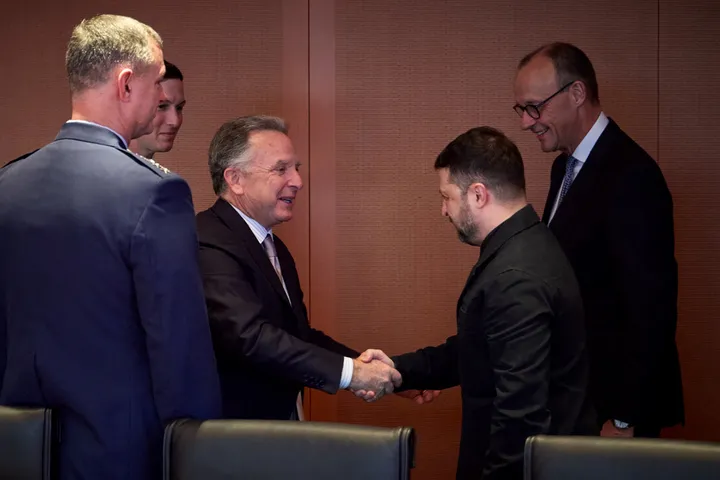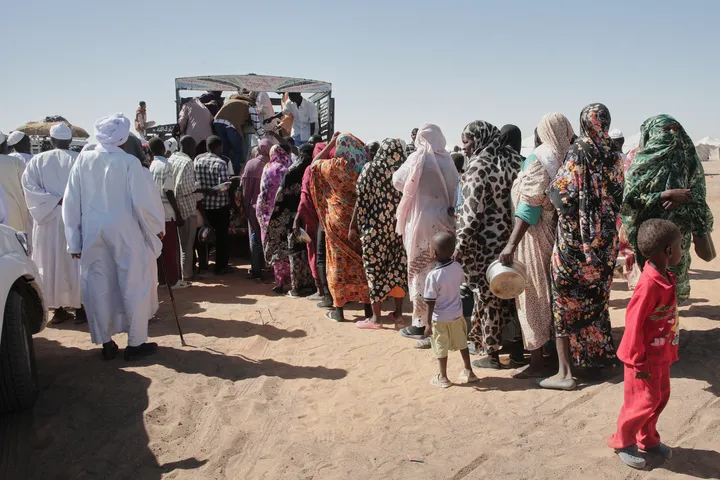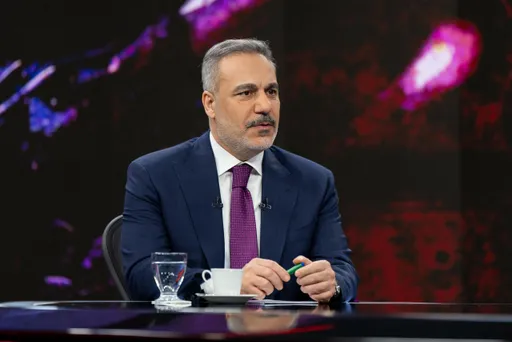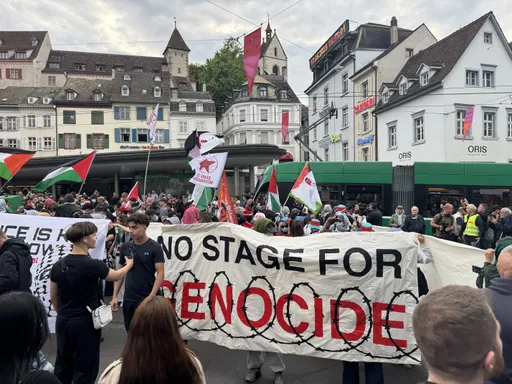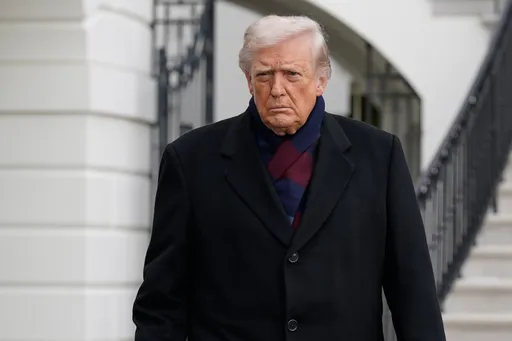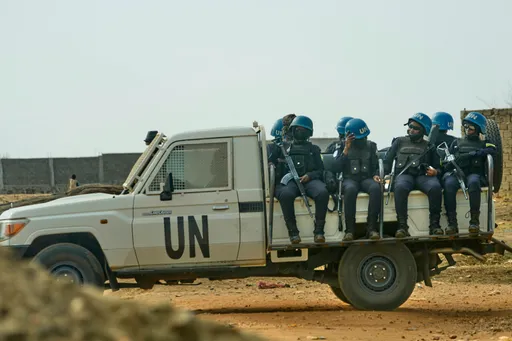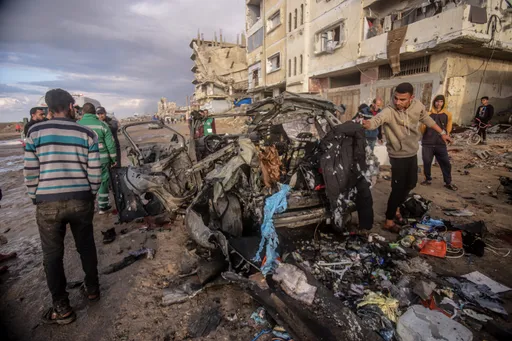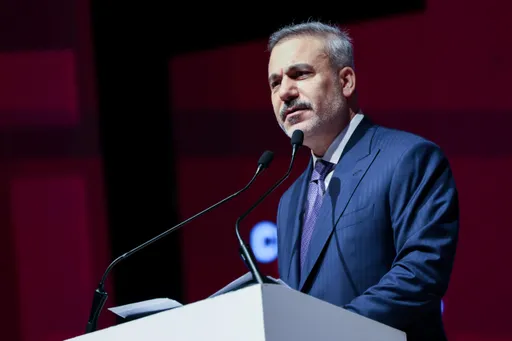"Two-state solution."
Last week, during his fourth tour of the Middle East since Israel’s war on Gaza began, US Secretary of State Antony Blinken once again brought up three words that have been bandied about for decades.
Blinken is reported to have reminded Israeli Prime Minister Benjamin Netanyahu, and his ultranationalist war cabinet, that establishing a Palestinian state is key to building geopolitical relations with Israel’s neighbouring Arab states once the war eventually ends. So what is the two-state solution, why has it never been implemented and is it still even a viable option?
At its simplest, it means a secure, sovereign Palestinian state that neighbours an equally secure and sovereign Israel, with a shared capital city of Jerusalem.
Some plans show the now fragmented West Bank under the Israeli occupation connected through a corridor to Gaza on the west.
This utopic Palestinian state would be home to some six million Palestinians, who would be able to move freely and securely between both areas, with no security checks, no blockades and no bombings.
Essentially, they would be comfortably coexisting on either side of a non-aggressive Israel, Leila Farsakh, a policy analyst with Palestinian affairs think tank Al Shabaka, told TRT World.
“It’s a fantastical idea to have two states living side by side without ever addressing the details that divide them, which is what countless rounds of talks have actually been doing,” she added.
Indeed, from the very beginning, the concerns of both would-be sovereign states have never been addressed.
The idea of carving out two states was first put on the table in 1937, when Palestine was under British mandate. Neither the State of Israel, nor the United Nations (nor its non-binding resolutions for that matter), had yet been created.
Unrest had been mounting. A growing Jewish population had steadily increased in number since thousands arrived after fleeing persecution in Europe to lay claim on ancient holy land. They would clash with a centuries-old local Arab population made up of Muslims and Christians who already called the land home. Arabs and Jews thus both staked claims to the right to self-determination in historical Palestine.
The British would take it upon themselves to propose a solution to a problem they had effectively created. Under the Peel Commission, it suggested that 20 percent of Palestine’s most fertile land be given to form a Jewish state.
The deal was quickly rejected by the Palestinian Arabs, who did not wish to relinquish their homes and their lands. They had instead wanted a sovereign democratic state, as had been earlier agreed with the British, with protected rights for Jewish minorities.
Israel, on the other hand, took the deal after it was put back on the table, this time repackaged by the UN in 1948 (Resolution 181). Except now 55 percent of historic Palestine was given to a Jewish minority to secure a homeland for its people.
This resolution paved the way for the razing of more than 500 Palestinian villages. Some 15,000 Palestinians were murdered by Zionist militia, and around 750,000 Palestinians were exiled from their homeland – never being allowed to return to their homes.
This period of violent statecraft became known to Palestinians as the nakba, or the catastrophe. What remained as land for the remaining Palestinians would fall under the West Bank, governed by Jordan, and Gaza, governed by Egypt, as transitory measures until Palestine could self-govern.
Israel seized all this land after the Arab-Israeli War in 1967, and although a recognised Palestinian leadership would come later, Israel had already cemented its role as coloniser.
Finding a way to coexist in this transformed geopolitical landscape of occupier and the occupied would busy diplomats and negotiators for the next six decades, with the concept of two states being raised whenever a US president started thinking about his legacy.
According to Farsakh, “It has always been the same format, the same narrative, and the same stumbling blocks – if the same roadmap hasn’t worked the first, second or third time, perhaps the problem was in the proposal itself?”
Such stumbling blocks included (and still include): the existence of Israeli settlements in the West Bank – there are now around 750,000 illegal settlers with settlements steadily expanding; disputes on the exact borders between where a new Palestine and Israel could coexist; the right to return for Palestinian refugees and their descendants who left or were exiled in 1948; and Jerusalem as a shared capital.
Was a two-state solution ever a real option?
Yes, it could have been, Israeli historian Ilan Pappe told TRT World.
“A viable Palestinian state, made up of the West Bank and Gaza, could have emerged after the June 1967 War.”
This was a war Israel stated was necessary for self-defence, and whose outcome saw soldiers invade and occupy a further 22 percent of Palestine, as well as land belonging to Egypt and Syria.
But Pappe, who is also a history professor at the University of Exeter, explained: “It depended solely on Israel, which did not wish to see a genuine and sovereign state from the first moment of the occupation. The best it could offer was a bantustan and from 1969 onwards, that (apartheid) bantustan shrunk in terms of space and authority.”
A concrete plan to legitimise a Palestinian state alongside Israel would come decades later as an outcome of the Oslo Accords in 1993, where the Palestine Liberation Organization (PLO’s) chairman, Yasser Arafat, would meet Israeli Prime Minister Yitzhak Rabin in talks orchestrated by US President Bill Clinton.
It was here that Israel recognised the PLO as representing the Palestinian people – with the PLO agreeing in return to end armed resistance and recognise Israel as a legitimate state. Progress?
But other important matters were left hanging, like Israeli military presence in Palestinian territories, the transfer of authority to a Palestinian administration, the status of Jerusalem, and illegal Israeli settlements – all to be negotiated at a later date (but which never were).
Daniel Levy is the president of the US / Middle East Project (USMEP), an organisation that tries to find a mutually dignified and acceptable resolution to the Israel-Palestinian conflict. He was also a former advisor to Rabin during the Oslo II talks in 1995, which went into the details on the structure of the peace process.
Speaking to TRT World, he said, “I think it's reasonable to say that the jury is out on whether a two-state solution was ever possible. The initial Oslo breakthrough happened at a moment of American unipolar power and at a moment where the leadership in both parties (Israeli and Palestinian) seemed to be edging towards that kind of dispensation.
“That's different from saying that the two-state option on offer would have been just or acceptable to everyone – obviously there was opposition on both sides.”
Levy added that the offer left Palestinian refugees excluded, in particular, and their rights ignored.
To make it work, the US should have held Israel to account and accepted the Palestinians' call for “a mini-state based on 22 percent of the historic land," he said.
Instead, “Israel continued to chip away at what even a mini Palestinian state would consist of, and that played a major role in collapsing the prospects. Just look at the number of settlers, the outpost, and the entrenchment of occupation, inequality and Israeli domination," Levy said.
A final treaty was slated to be reached in five years – but that never happened.
Future diplomatic talks would continue to pitch the same solutions mired by the same problems, at the Camp David Summit (2000), the Taba Summit (2001), the Arab Peace Initiative (2002), the Middle East Road Map to Peace (2003) and the Annapolis talks (2007).
Farsakh, also the author of "Rethinking Statehood in Palestine" (2021), said: "The international legal framework for resolving the Israeli-Palestinian conflict has remained tied to the two-state solution, but the reality Israel created on the ground since 1993, by including the presence of 730,000 settlers in the West Bank and East Jerusalem, means that concretely we cannot implement a viable two-state solution."
She added that policymakers and civil society leaders should have found ways to think "outside the box" and offer an alternative paradigm.
Can there be peace with no Palestine?
Unlike the 2002 Arab Peace Initiative led by the Saudis, where a baseline was set to insist on a resolution for Palestine by the Arab world, the Abraham Accords (2020) brokered by the Trump administration, made no such effort.
This was in part to relegate and marginalise the need to address Palestinian rights, Levy explained.
"While these accords did not endorse a greater Israel one-state outcome, what they crucially did was to further empower an Israeli approach to decentering Palestine, and indeed to crushing Palestinian rights."
The concept of not taking this conflict seriously has blown up in everyone's face. From the perspective of (the war) today, it should be embarrassing to look at what was done. To think that creating diplomatic relations between countries not at war, and doing so in ways that marginalise the Palestinians, would contribute to the resolution of that conflict, is patently absurd.
Levy added that the Abraham Accords are an example of “massively irresponsible politics." Alluding to Israel and Saudi Arabia's overtures at normalisation, he said:
"The concept of not taking this conflict seriously has blown up in everyone's face. From the perspective of (the war) today, it should be embarrassing to look at what was done. To think that creating diplomatic relations between countries not at war, and doing so in ways that marginalise the Palestinians, would contribute to the resolution of that conflict, is patently absurd."
Perhaps with this realisation, Blinken has now alerted Israel that in order to resume its normalising of relations with regional countries, it must accede to a two-state option. Saudi Arabia has said it won't agree to any deal if the Israeli government doesn't commit to the principle of a two-state solution.
But Israel has never promoted the idea.
Israel’s rejection
Israeli media described Netanyahu in 2019 as "the man who has done more than anyone else in the last quarter-century to prevent a Palestinian state from becoming a reality."
In fact, of late, Netanyahu and his far-right government have openly rejected the creation of a Palestinian state alongside Israel, instead stating it will return to maintaining security control over Gaza.
In December, he declared "Gaza will be neither Hamastan nor Fatahstan" – a suggestion that neither of the main Palestinian parties would be allowed to govern Gaza after the war ends.
National Security Minister Itamar Ben-Gvir and ultranationalist Finance Minister Bezalel Smotrich have gone a step further, suggesting “voluntary migration” of Palestinians to Democratic Republic of Congo, although a government spokesman for the central African country denies any involvement in this.
Speaking about Netanyahu's motives, Farsakh said, “He wants the elimination of the Palestinians either by expulsion or by fragmenting them under various legal and geographic spaces so they become a fragmented humanitarian problem rather than (have) a legitimate claim to self-determination and independence."
Where do the Palestinians stand?
The Western-backed Palestinian Authority, Palestine’s official leadership, lacks legitimacy in the view of many Palestinians as it’s seen to be in collusion with Israel. But its leader Mahmoud Abbas continues to call for a two-state solution. Remember the authority’s forces were driven from Gaza when Hamas took over the enclave in 2007, after winning Palestinian parliamentary elections in 2006.
In 2017, Hamas accepted a two-state solution based on the 1967 borders, without recognising the state of Israel. But since the latest conflict began and the death toll in Gaza approaches 25,000 people, the two-state concept may have become buried under the rubble.
A poll by the Palestinian Center for Policy and Survey Research, carried out in November and December in Gaza, found that only 34 percent of Palestinians there support a two-state solution. Some 64 percent of Palestinians said that they do not support a two-state solution.
It’s a sentiment Mustafa Barghouti, from the political party the Palestinian National Initiative, has also raised time and again.
In an opinion piece for The Guardian in May, he wrote: “Europe and the United States have continued to pressure Palestinians to accept a two-state solution that perpetuates inequality and suffering, with no regard to our right to self-determination and without any serious effort to stop settlement building.”
Farsakh agreed, saying too much has happened since the two-state model was a serious option in the 1990s. “The four core issues which still hang over it are complex, including settlers, security, refugees and Jerusalem.”
So if not two states, then maybe one?
“The only option before October 7 is the same as the one after,” Pappe said. “A political system that offers equal rights to everyone regardless of their religion or ethnicity, including the refugees expelled from Palestine in 1948 and ever since. Any other vision, or plan, will perpetuate the bloodshed and violence."
Farsakh also called for the creation of one state founded on the basis of equal rights. There is “large Palestinian support for the idea of one democratic state, but we have no political vehicle to present it and defend it regionally and globally," she said.
A jointPalestinian-Israeli poll from January 2023 found that 52 percent of Israel’s Palestinian citizens would support a shared state with equal rights for Jews and Palestinians, compared to just 20 percent of Israel’s Jewish citizens. About one in three Palestinians said they would support such a plan.
But it has its own pitfalls.
Palestinians would make up at least half the population, meaning Israelis would be in the minority, thus annulling the concept of Israel as a Jewish state.
Levy explained there are many different models for a one-state solution, including a binational system, federal system, or confederation, but whatever form it takes, it would have to address two crucial points – “equal rights for all and almost certainly national collective rights as well."
He added, "It's not the time to put out blueprints for solutions. We are in a moment to learn from the past, address the root causes which are from at least 1947-49, not just from 1967, and especially to address the many shortcomings which the current disaster has exposed.
"What we have seen since October 7, is that no wall can be high enough to give security alongside injustice. It might be that people over time acknowledge that a better way forward is actually to accept the humanity of the other, which is perhaps more acknowledged in a dispensation of one political entity offering equality rather than in a separationist paradigm."


